
|
Sale 47
Pre-Long Beach Coin and Currency Auction
| Lot |
Photo |
Description |
Realized |
Lot 4496 |
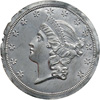 |
1859 Master Die Splasher. Judd-A1859-10. White metal. Listed in Appendix A: Die and Hub Trials and Splashers in the Judd book. Only 3 examples known, two of which are in the Library Company of Philadelphia making this the only one available. Razor-sharp detail from the tight squeeze the dies gave it, producing a look of utter beauty. As the Mint prepares new designs and works them into hubs and master dies, it periodically does tests to see the progress. Most often, these test pieces such as the splasher in this lot, are discarded afterwards. Only a few ever.
Estimated Value $10,000 - 11,000.
View details and enlarged photos
| Realized
$13,225 |
Lot 4497 |
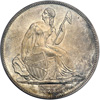 |
1836 Pattern Dollar. Silver, plain edge. Restrike. PCGS graded Proof 61 PQ. CAC Approved. Name below base. A rare coin. Housed in an old green holder number 4104094. Listed in the standard Pattern reference as Judd-58, this has long been an issue surrounded by controversy and heated debate. Is it original (meaning struck in 1836; or could they have been minted in after years, that is, are they restrikes, struck perhaps as late as 1860? What is known for certain is that the line C. GOBRECHT F. stands for Christian Gobrecht, fecit (= "made this.") The fields are muted from the passage of time with evidence of light hairlines on each side. Mostly toned in varying light shades, there is an area of deeper steel with gray iridescence below the eagle. Sharply struck in all areas, including Liberty's foot, this underscores the high production standards used at the mint as early as 1836. This classic of American numismatics is rare enough that bidders may have to wait years for the next offering. Curiously, there are evidently no examples of Judd-58 known in the Smithsonian. Low Rarity 6. Pop 3; 12 finer, 2 in 62, 6 in 63, 2 in 64, 2 in 65 (PCGS # 11217) .
Dies for the Gobrecht dollar Patterns were engraved in 1836 by Christian Gobrecht, assistant to the ailing Chief Engraver, William Kneass. Gobrecht used as his model sketches made by Titian Peale and Thomas Sully. The obverse has the familiar figure of Liberty with flowing dress, seated on a rock, a staff and liberty cap in her hand. At the base, a shield inscribed LIBERTY in raised letters. An American eagle, some say modeled after Peter, the mint's adopted eagle, flies to the left within a field of twenty-six varying-sized stars. The 13 largest stars are meant to represent the original colonies, while the 13 smaller ones bring up the total to the number of states admitted to the Union since colonial times. (Michigan, the 26th states, was admitted in 1837.) UNITED STATES OF AMERICA and ONE DOLLAR around.
Estimated Value $60,000 - 70,000.
View details and enlarged photos
Check results on similar lots
| Realized
$60,375 |
Lot 4498 |
 |
1836 Pattern Dollar. Silver, plain edge. PCGS graded Proof 62. Rarity 1. Original coin alignment. Nicely toned. A popular Gobrecht Pattern dollar. Nice reflective surfaces; some light marks. One thousand pieces were minted in December, 1836 of the design with Gobrecht's name on the base; all have a Proof finish. Some were no doubt presented to congressmen, two went to President Andrew Jackson, others were acquired by various Treasury Department officials, and a few went into to numismatic cabinets. Afterwards, many hundreds are believed to have been put into circulation for face value, accounting for the large number of circulated pieces that are known. For years the variety was described as a pattern, earning a Judd number of 60 (Pollock-65). However, some think this is now misdirected. The pieces were regular issue, but struck as Proofs, neither patterns nor experimental in any fashion. Pop 34; 36 finer, 23 in 63, 13 in 64 (PCGS # 11225) .
Estimated Value $20,000 - 23,000.
View details and enlarged photos
Check results on similar lots
| Realized
$21,850 |
Lot 4499 |
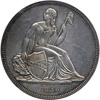 |
1836 Pattern Dollar. Silver, plain edge. Rarity 1. NGC graded Proof 61. Lightly toned. An attractive Proof of the optimum, defect free quality for this grade. Gobrecht's name appears on the base of the perch on which Liberty sits. The field, unlike what would be the standard way seated coins are presented in later years, lacks the 13 stars around Liberty. This gives the coin an almost cameo-like appearance. Collectors find it beautiful. The reflective surfaces show signs of mingled medium gray with deeper grade shades of toning. Agreeably well struck to say the least, in fact fully so, with detail aplenty to merit special reference here.
The United States Mint had ceased striking silver dollars in 1804. Although the denomination was the standard monetary unit in U.S. coinage, demand for it came mostly from bullion depositors, and few dollar coins circulated in the beginning of the 19th century. Half dollars were preferred. Much of each year's silver dollar mintage was either melted domestically or exported. By the 1820s and '30s however, two successive Mint directors, Samuel Moore and Robert M. Patterson, had advocated reviving dollar coinage. The 1836 Gobrecht coins are the first tries at issuing silver dollars again, which would go into regular (if limited) production in with the modified seated Liberty dollar in 1840 (PCGS # 11227) .
Estimated Value $19,000 - 21,000.
View details and enlarged photos
Check results on similar lots
| Realized
$27,600 |
Lot 4500 |
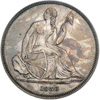 |
1836 Pattern Dollar. Silver, plain edge. PCGS graded Proof 55. Nice grey toning on both sides with some handling marks and hairlines. There is a small ding in the left field by Liberty's elbow. Rims are choice, the surface condition acceptable overall, though with uneven toning. One of the most discussed early silver dollars in American numismatics, the coin's designer was the noted die engraver Christian Gobrecht. So famous was his flying eagle, that later Mint engraverse from Longacre to Saint-Gaudens to the present staff at the Philadelphia Mint used it for their model. Rarity 1 Pop 10; 72 finer (PCGS # 11227) .
Estimated Value $15,000 - 16,000.
View details and enlarged photos
Check results on similar lots
| Unsold |
Lot 4501 |
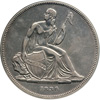 |
1836 Pattern Dollar. Silver, plain edge. Rarity 1. NCS graded Details of Proof 45. Improperly cleaned. The surfaces, while evidencing some old cleaning, will return to a natural "old silver" hue in time, leaving this as a fairly attractive reminder of an era in American history when the Mint really accomplished a lot with artistic coin design. The silver dollars of 1836, while struck in Proof, were also released into circulation by the Mint after quantities had been given or sold to friends of the government and other important persons. This piece shows Gobrecht's original rendition for Liberty seated on a rocky outcrop, her gown diaphanous and flowing. The eagle is similarly well executed and infinitely detailed to where studying it with a glass gives hours of enjoyment to the student of numismatics (PCGS # 11227) .
Estimated Value $10,000 - 11,000.
View details and enlarged photos
Check results on similar lots
| Unsold |
Lot 4502 |
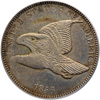 |
1856 Pattern Cent. Nickel, plain edge. High Rarity 7. PCGS graded Proof 61. Softly struck in the center of both sides, which is likely the result of the unexpected hard alloy chosen for this early Pattern Cent struck in nickel. The mint hadn't used such a hard metal for regular circulation coinage up to that time. One of the least familiar 1856 Patterns, this Cent employs the Longacre flying eagle obverse as adopted for regular coinage, with ONE CENT in a wreath of corn, wheat, cotton and tobacco. Why do we say "least familiar"? For the simple reason that this Judd-183 variety is Exceedingly rare. It rarely turns up in auctions. Only 5 examples graded by PCGS. Pop 1; 4 finer, 3 in 62, 1 in 64 (PCGS # 11805) .
Estimated Value $15,000 - 17,000.
View details and enlarged photos
Check results on similar lots
| Realized
$21,850 |
Lot 4503 |
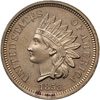 |
1858 Pattern Cent. Copper-nickel, plain edge. Rarity 1. Proof 60. Some small spots on both sides. This is the desirable transitional issue with identical designs to the adopted 1859 Indian cent, but dated 1858. On the reverse, ONE CENT is in a laurel wreath. Issues of this type were struck in copper-nickel (J-208), copper (J-209), and bronze (J-210) (PCGS # 11885) .
Estimated Value $500 - 550.
View details and enlarged photos
Check results on similar lots
| Realized
$805 |
Lot 4504 |
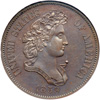 |
1859 Pattern Half Dollar. Copper, reeded edge. Rarity 5. NGC graded Proof 63 Brown. Warm brown hues and choice preservation. The devices sharply defined by a strict hard blow from the dies. A popular, affordable Pattern half dollar featuring the Longacre designs. On the reverse, HALF DOLLAR is within a cereal wreath composed of cotton, tobacco, sugar cane, corn, wheat and oak leaves. A similar wreath was used on the regular production Legend Obverse half dimes and dimes in 1860. Pop 4; 4 finer, 1 in 64, 1 in 65, 2 in 66 (PCGS # 11968) .
Estimated Value $1,800 - 1,900.
View details and enlarged photos
Check results on similar lots
| Realized
$2,185 |
Lot 4505 |
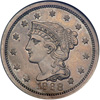 |
1868 Pattern Ten Cents. Nickel, plain edge. Low Rarity 6. NGC graded Proof 62. Lightly toned. The head of Liberty on this interesting Pattern is the one used on the last large cents of 1857. The reverse has TEN CENTS within a laurel wreath. Scarce issue struck in nickel alloy. Weight: 10 grams (which is exactly twice the gram weight of the standard shield 5c pieces of the year) (PCGS # 60865) .
Estimated Value $2,400 - 2,600.
View details and enlarged photos
Check results on similar lots
| Realized
$3,220 |
Lot 4506 |
 |
1869 Pattern Three Cents. Nickel, plain edge. Rarity 4. NGC graded Proof 62. Nicely toned. A head of Liberty similar to the adopted Longacre design wearing a coronet inscribed LIBERTY, incused. The Roman III in a laurel wreath; numerals have a smooth surface (on the adopted coins, the numerals are ribbed) (PCGS # 60901) .
Estimated Value $1,200 - 1,300.
View details and enlarged photos
Check results on similar lots
| Realized
$1,150 |
Lot 4507 |
 |
1870 Pattern Half Dime. Silver, reeded edge. NGC graded Proof 66 PQ. CAC Approved. Low Rarity 7. Lovely blue toning. A dazzling toned coin whose radiant mirrors glow with gorgeous iridescence. This carries William Barber's petite version of a seated figure of Liberty (in this incarnation, she is facing left), with the expected pole and liberty cap along with the Union shield and scroll inscribed LIBERTY, all presented in delicate detail for the connoisseur to admire (PCGS # 61059) .
Estimated Value $3,500 - 4,000.
View details and enlarged photos
Check results on similar lots
| Realized
$4,830 |
Lot 4508 |
 |
1871. Longacre's Indian Princess Design Pattern Set. Consists of: Half Dime J-1059 NGC PF66 Pop 1; none finer, Dime J-1074 NGC PF66 Pop 2; none finer, 25¢ J-1090 NGC PF67 Pop 1; none finer, 50¢ J-1105 NGC PF66 Pop 1; none finer, $1 J-1121 NGC PF66 Pop 1; none finer. All High Rarity. Each coin marvelously toned, all are superb examples of their type, in all cases but one, the Finest Certitied, rarities all!
1871 continues the appearance of Longacre's famous Indian Princess design on Pattern coins introduced in 1870. The motif (in modified form) subsequently appeared on later varieties through 1873. Collectors agree almost to a man that had it been adopted for circulation, the Indian Princess set would have made a beautiful addition to the nation's coinage. The design was by James Barton Longacre, Mint Engraver from 1844 until 1869. Longacre adapted Liberty's head ornamentation in modified form from his 1854 Type 2 and Type 3 gold dollars as well as the similar $3 gold pieces introduced in 1854. Liberty's seated figure faces to the left. At her side, in place of the Union shield is a globe of the world inscribed LIBERTY on a ribbon, the letters of which are raised instead of incuse. Behind are two flags. On the larger denomination (dollar) the initials J.B.L. are below the base at right.
Each coin in this unique set of Indian Princess Types uses a design without obverse stars. The reverses employ Longacre's cereal wreath consisting of cotton and corn, with the word STANDARD above the wreath.
Longacre created three versions of a cereal wreath, two of which made it to circulating coinage while this third wreath remained exclusively on the STANDARD series of Pattern coins (but not the STANDARD SILVER inscribed Patterns, which employ yet a different style wreath altogether). The Longacre "cereal wreath" which is used on the flying eagle cents, the gold dollars (type 2 and 3) as well as the $3 gold pieces, is comprised of corn, wheat, cotton and tobacco. Another "cereal wreath" comprises cotton, tobacco, sugar cane, corn, wheat and oak leaves and is used on numerous Patterns as early as 1859, as well as the regular issue half dimes and seated dimes introduced in 1860.
According to William T. Gibbs, a "Coin World" staff writer, "The Treasury Department and Congress in 1870 were considering a major revision of U.S. laws involving coinage and the Mint, with John Jay Knox, then deputy comptroller of the currency (he later became comptroller), serving as special investigator into the needed changes and charged with writing a report with recommendation.
"Knox wrote his report in early 1870 and delivered it in April; he also wrote draft legislation based on his report, and it was submitted to Congress. Both included a provision for a "standard" silver dollar: a 90 percent fine silver dollar weighing 384 grains. (the existing silver dollar weighed 412.5 grains). Such a dollar would be exactly twice as heavy as the 90 percent silver half dollar then in production (the 1853 reduction in the weight of silver coins did not include the silver 3-cent coin or dollar, which remained at their existing weights), rather than more than twice the lower denomination's weight.
"Mint officials, however, rejected the idea of issuing the standard silver dollar recommended by special investigator Knox. Acceding to their wishes, he deleted the standard silver dollar provision from his draft. Knox's draft legislation languished in Congress from the summer of 1870 to February 1872. That was when a House committee inserted an amendment seeking a "trade" dollar weighing 420 grains and composed of 90 percent silver."
It was during this period, when the provisions for a STANDARD coinage was still being debated, that the Mint produced this exquisite series Pattern coins at the new proposed weight standard. A magnificent set of Indian Princess Patterns destined for the finest collection of such pieces. Lot of 5 coins.
Estimated Value $190,000 - 210,000.
Ex: Garrett Collection.
View details and enlarged photo
| Unsold |
|
|